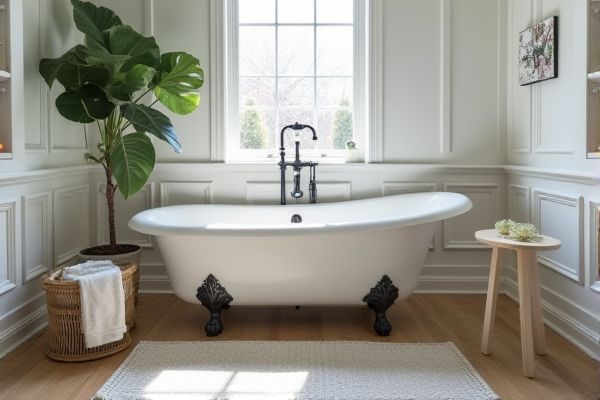
Cast iron tubs offer unmatched durability and heat retention, providing a long-lasting, classic bathing experience, while acrylic tubs are lightweight, easier to install, and available in a variety of styles and colors to suit modern bathrooms. Explore the rest of this article to determine which tub best fits your needs and enhances your bathroom.
Table of Comparison
| Feature | Cast Iron Tub | Acrylic Tub |
|---|---|---|
| Material | Heavy-duty cast iron coated with enamel | Lightweight, molded acrylic plastic |
| Durability | Highly durable, resists chipping and scratching | Less durable, prone to scratches and cracks |
| Weight | Very heavy (150-300 lbs) | Lightweight (50-70 lbs) |
| Heat Retention | Excellent, retains heat for long baths | Moderate, cools down faster than cast iron |
| Installation | Requires strong floor support due to weight | Easier and quicker to install |
| Cost | Higher initial cost | More affordable upfront |
| Maintenance | Low maintenance, resistant to stains | Needs regular care to avoid staining and fading |
| Aesthetic | Classic, vintage look with glossy finish | Modern appearance with customizable colors |
| Longevity | Can last 50+ years | Typically lasts 10-20 years |
Introduction to Cast Iron and Acrylic Tubs
Cast iron tubs are renowned for their exceptional durability, heat retention, and classic aesthetic, often featuring a porcelain enamel coating that resists scratches and stains. Acrylic tubs, made from lightweight, moldable plastic, offer flexibility in design, ease of installation, and superior resistance to chipping compared to cast iron. Choosing between these materials impacts your bathroom's style, maintenance needs, and long-term comfort during bathing.
Material Composition: Cast Iron vs Acrylic
Cast iron tubs are made from molten iron poured into molds and coated with a durable enamel finish, offering superior strength, heat retention, and longevity. Acrylic tubs consist of a lightweight, flexible plastic material formed from polymer resins that provide ease of installation, warmth, and resistance to chipping or cracking. Your choice depends on whether you prioritize the traditional sturdiness and heat retention of cast iron or the modern versatility and lighter weight of acrylic.
Durability and Longevity Comparison
Cast iron tubs offer superior durability and can last over 50 years due to their dense, non-porous material and resistance to chipping or cracking. Acrylic tubs are lighter and less expensive but typically have a shorter lifespan of 10 to 15 years, as they are more prone to scratches and discoloration. Choosing a cast iron tub ensures your bathroom investment withstands wear and maintains structural integrity longer than acrylic alternatives.
Weight and Installation Challenges
Cast iron tubs weigh between 300 to 500 pounds, requiring reinforced flooring and professional installation due to their heavy, rigid structure. Acrylic tubs typically weigh 60 to 100 pounds, allowing for easier handling, quicker installation, and compatibility with most standard bathroom floors. The significant weight difference impacts labor costs, installation complexity, and structural considerations in bathroom remodeling projects.
Heat Retention and Bathing Comfort
Cast iron tubs excel in heat retention due to their dense, heavy material, keeping your bathwater warm longer and enhancing overall bathing comfort. Acrylic tubs, while lighter and easier to install, lose heat more quickly because of their porous surface and lower thermal mass. Choosing a cast iron tub ensures a more relaxing, warm soak, especially during extended baths or cooler seasons.
Aesthetic Choices and Design Varieties
Cast iron tubs offer timeless elegance with classic designs and a glossy enamel finish that suits traditional and vintage bathroom styles, while acrylic tubs provide a wide range of shapes, colors, and textures, allowing for modern and customizable aesthetic choices. The heavy, durable nature of cast iron supports intricate detailing, whereas acrylic's versatility enables unique curves and integrated features tailored to your design preferences. Choosing between these materials depends on whether you prioritize the enduring beauty of cast iron or the design flexibility and vibrant options of acrylic tubs.
Maintenance and Cleaning Requirements
Cast iron tubs require periodic sealing of the enamel surface and use of non-abrasive cleaners to prevent chipping and rust formation, ensuring long-term durability. Acrylic tubs demand gentle cleaning with mild, non-abrasive products to avoid scratching and discoloration while being more resistant to stains and easier to maintain on a daily basis. Both materials benefit from regular rinsing and wiping to prevent soap scum buildup, but cast iron's heavier maintenance routine corresponds to its superior robustness.
Cost Comparison: Upfront and Long-Term
Cast iron tubs typically have a higher upfront cost ranging from $600 to $1,200, while acrylic tubs cost between $300 and $700 initially. Long-term expenses for cast iron include potential refinishing due to chipping but offer superior durability and heat retention, reducing heating costs over time. Acrylic tubs may require more frequent replacement or repairs, increasing lifetime costs despite their lower initial price.
Environmental Impact and Sustainability
Cast iron tubs offer superior environmental sustainability due to their durability and recyclability, often lasting 50-100 years and made from abundant natural materials. Acrylic tubs, while lightweight and easier to install, rely on petroleum-based plastics that contribute to pollution and have a shorter lifespan, typically around 10-15 years. Choosing a cast iron tub can reduce your environmental footprint by minimizing waste and promoting resource recovery.
Choosing the Right Tub for Your Bathroom
Cast iron tubs offer exceptional durability and heat retention, making them ideal for long, relaxing baths and a classic bathroom aesthetic. Acrylic tubs are lightweight, easier to install, and provide a wide variety of shapes and sizes, enhancing modern bathroom designs with budget-friendly options. Selecting the right tub depends on factors such as bathroom size, budget, heat retention preferences, and maintenance requirements.
 homyna.com
homyna.com